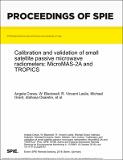| dc.contributor.author | Crews, Angie | |
| dc.contributor.author | Blackwell, Bill | |
| dc.contributor.author | Leslie, Vince | |
| dc.contributor.author | Cahoy, Kerri | |
| dc.contributor.author | DiLiberto, Michael | |
| dc.contributor.author | Milstein, Adam | |
| dc.contributor.author | Osaretin, Idahosa | |
| dc.contributor.author | Grant, Michael | |
| dc.date.accessioned | 2021-11-09T15:57:09Z | |
| dc.date.available | 2021-11-09T15:57:09Z | |
| dc.date.issued | 2018-10-09 | |
| dc.identifier.uri | https://hdl.handle.net/1721.1/137939 | |
| dc.description.abstract | © 2018 SPIE. Miniaturized microwave radiometers deployed on nanosatellites in Low Earth Orbit are now demonstrating cost-effective weather monitoring capability, with increased temporal and spatial resolution compared to larger weather satellites. MicroMAS-2A is a 3U CubeSat that launched on January 11, 2018 with a 1U 10-channel passive microwave radiometer with channels near 90, 118, 183, and 206 GHz for moisture and temperature profiling and precipitation imaging. 1 The Time-Resolved Observations of Precipitation structure and storm Intensity with a Constellation of Smallsats (TROPICS) mission is projected to launch in 2020, and its 1U 12-channel passive microwave radiometer is based on the current CubeSat mission MicroMAS-2A. TROPICS will provide rapid-refresh measurements over the tropics and measure environmental and inner-core conditions for tropical cyclones. 2 In order to effectively use small satellites such as MicroMAS-2A and TROPICS as a weather monitoring platform, calibration must ensure consistency with state of the art measurements, such as the Advanced Technology Microwave Sounder (ATMS), which has a noise equivalent delta temperature (NEDT) at 300 K of 0.5 - 3.0 K. 3 In this work, we present initial analysis from the MicroMAS-2A radiometric bias validation, which compares MicroMAS-2A measured brightness temperatures to simulated brightness temperatures calculated by the Community Radiative Transfer Model (CRTM) using input from GPS radio occultation (GPSRO), radiosonde, and numerical weather prediction (NWP) atmospheric profiles. We also model solar and lunar intrusions for TROPICS, and show that the frequency of intrusions with a scanning payload allows for the novel opportunity of using the solar and lunar intrusions as a calibration source. | en_US |
| dc.language.iso | en | |
| dc.publisher | SPIE | en_US |
| dc.relation.isversionof | 10.1117/12.2325757 | en_US |
| dc.rights | Article is made available in accordance with the publisher's policy and may be subject to US copyright law. Please refer to the publisher's site for terms of use. | en_US |
| dc.source | SPIE | en_US |
| dc.title | Calibration and validation of small satellite passive microwave radiometers: MicroMAS-2A and TROPICS | en_US |
| dc.type | Article | en_US |
| dc.identifier.citation | Crews, Angie, Blackwell, Bill, Leslie, Vince, Cahoy, Kerri, DiLiberto, Michael et al. 2018. "Calibration and validation of small satellite passive microwave radiometers: MicroMAS-2A and TROPICS." | |
| dc.contributor.department | Massachusetts Institute of Technology. Department of Aeronautics and Astronautics | |
| dc.contributor.department | Lincoln Laboratory | |
| dc.eprint.version | Final published version | en_US |
| dc.type.uri | http://purl.org/eprint/type/ConferencePaper | en_US |
| eprint.status | http://purl.org/eprint/status/NonPeerReviewed | en_US |
| dc.date.updated | 2019-10-24T14:55:10Z | |
| dspace.date.submission | 2019-10-24T14:55:14Z | |
| mit.license | PUBLISHER_POLICY | |
| mit.metadata.status | Authority Work and Publication Information Needed | en_US |
